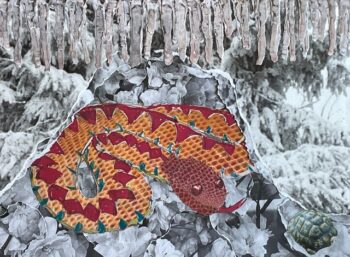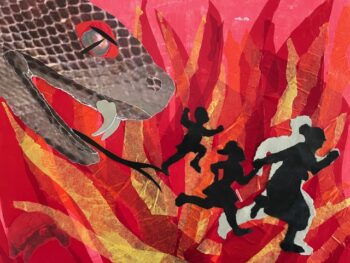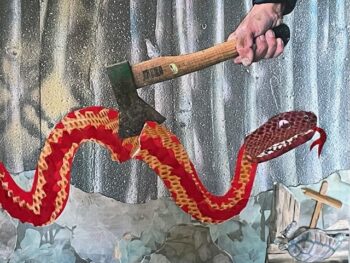The Man and the Snake
Annelie van Steenbergen, text and illustrations
November 2025
Turtles and snakes are not on the so-called list of pets and hobby animals. Since July 1, 2024, only mammals that are on that list may be bought, kept, or sold. Turtles and snakes are not mentioned, as they are not mammals. For these animals, it is unclear whether they are suitable as a gift for a child asking for a pet. However, a list of pets and hobby animals for reptiles, amphibians, and birds is on its way. The reason for this is the overcrowded turtle shelters caused by the large number of animals being abandoned and released into the wild. A sample survey shows that there are approximately 200,000 abandoned turtles living in ponds, streams, and ditches in the Netherlands. How many of these reptiles, which can live to be very old, have met their end due to inexperienced, or let’s be honest, foolish behavior? Lack of knowledge is one of the main causes of death.
To my shame and disgrace, I speak from personal experience. As a little girl, at home we had, in addition to the usual pets like a dog, cat, and chickens, a Greek tortoise that wandered freely around our garden. Occasionally, I would look for him, follow him for a while, and feed him a leaf of lettuce. At some point, I couldn’t find him until I discovered him under some clutter in a corner of the shed. He lay there completely still. I assumed he had died and was deeply saddened. I put him in a box and ceremoniously buried him. Only years later did I realize that the animal was probably hibernating and that I had buried him alive.

This is what I thought of when reading the tenth fable by the Greek storyteller Aesop (620-500 BC) about The Man and the Snake.[2] In this fable, which was later adapted by Jean De La Fontaine (1621-1695), a snake stiffened by the cold is brought inside to be warmed up. Of course, not a good idea. And it ends badly. For Aesop, it ends badly for the man, and for De La Fontaine, for the snake.
The woodcut accompanying this fable by Aesop shows a doghouse-like little house with a fire burning inside. In the doorway stands a man, who is raising a sort of ladle above his head with both hands as a weapon. He is about to strike a large snake on the head with it. The enormous snake slides halfway out of the house and turns its head toward the man, either defensively or aggressively, which is unclear. Anything could happen next, but the text provides clarification.The text, based on the 1485 edition of Gheraert Leeu’s Esopus [3], recounts that a man had found a snake in his vineyard.
‘Because of the harsh winter and the cold that had been, she was completely frozen and lay on the ground as if dead. The man therefore felt great pity for her.’
He takes her home to warm her up. In this Middle Dutch adaptation, it is left ambiguous how exactly the snake is warmed. According to the illustration, he places the chilled snake by the fire, after which she soon recovers. However, there are also versions where the man even presses the snake, the serpent, to his heart to thaw her with his body warmth. This, in turn, evokes other interpretations that a psycho-analyst would know what to make of.
In any case, everything goes completely wrong.
‘When she had completely recovered, she began to scream and blow all over the house and to tear apart the woman and the children.’
The good man doesn’t take that, so he wants to throw her out of the house, but then the snake flies at his throat and starts to strangle him. End of story.

In Greece, there are no large constrictor snakes, neither then nor now. No giant anacondas, no boas or pythons. The only constrictor snake is the slender four-striped snake, which only suffocates and swallows small prey such as mice and young rabbits. These snakes are not aggressive towards humans unless cornered. Strangling an adult man or even a child is unthinkable.
In fables, it is of course not intended that we take the story literally. It is about a moral lesson. To convey it, animals are portrayed that represent human qualities. Apart from being a bringer of healing, vitality, and energy, a symbol of consciousness and renewal, the snake has traditionally also often been seen as treacherous, dangerous, and devilish, and that is no exception here. In this fable, the snake represents the evil man.
So here we naturally arrive at the symbolic meaning of the fable, which is expressed in the promythium, the moral lesson given at the beginning: This fable, according to Aesop,
‘teaches us that those who help an evil person commit a grave sin, because after one has helped him, he harms the one who did him good. It is commonly said: ‘If you rescue a thief from the gallows, he will never love you.’
There is also a moral at the end, the epimythium, which states that bad and ungrateful people often repay good with evil.
‘They deceive those who have pity on them. Therefore, their company is neither good nor useful, and should above all be avoided.’
In Aesop’s The Man and the Snake, the well-meaning man looses out to the presumed monster. He is strangled. In the adaptation by the seventeenth-century Jean De La Fontaine, it is the snake that meets its demise. Translated by Jan Jacob Lodewijk ten Kate (1819-1889) and beautifully illustrated by Gustave Doré (1832-1883), The Farmer and the Snake presents a different picture of the same event. Outstanding are the illustrations. A full-page woodcut shows a loving family by the burning hearth. An old man, sitting on a chair with two small children at his side, holds a limp little snake in his hands. Behind him stands his wife, watching with a smile. A typical example of care, love, and respect for nature and animal life. The second illustration shows a completely different scene: the man now strikes the snake like a madman, which writhes in separate pieces across the floor. The children are standing terrified on the kitchen chairs, and the lady of the house stands anxiously, half turned away a little further on. Poor snake, victim of a misunderstanding.
In La Fontaine, the constrictor has become an ordinary adder. In the very first sentence, he refers to Aesop.
‘’t Happened – as Aesop narrated –
That on a harsh winter day
A farmer, while wandering through his yard,
Saw a viper on a snowdrift,
Which, motionless, stiffened by the cold,
Perhaps had less than an hour to live.’
Just like in Aesop, the kind-hearted farmer takes the little animal home to let it recover by the fireplace. According to De La Fontaine, it does not occur to him that he is bringing a dangerous and poisonous snake into the house. He thinks he is doing a good deed and providing a benefit. Until the viper comes to life:
‘It raises its head high, hisses with a forked tongue,
And blows, and now coils itself, ready to leap at him
Who cherished it like a father.’

Like a father? Or a father who teaches his ungrateful child a lesson by cutting of his head. With a sharp axe he chops the beast into pieces, a head, a body and a tail. They meander on for a while, but then it’s over for good.
With De La Fontaine, in contrast to Aesop, the ungrateful loses out. It is not the farmer who is tricked, but the snake. The concluding moral is as follows:
‘Mercy is good, but consider whom you receive, for you may face harm and disgrace!
And as for the ungrateful, their end, sooner or later, will always be miserable.’
For De La Fontaine it is a settled matter. ‘The dragon would never tease anyone again,’ he says. The question that arises for the reader is: who is ‘teasing’ whom here? The comparison with the tortoise at the beginning of this story is quickly made. There too, a lack of knowledge leads to the death of another living being. Snakes, like tortoises, are reptiles. They hibernate, called ‘brumation‘ in snakes. As winter approaches, they stop eating, look for a sheltered safe place, for example, in cracks in old walls or under tree roots, and barely move. Only when the temperature rises do they become active again. An animal that has curled up in a little burrow and remains motionless to protect itself from the cold should be left alone if you do not know what you are doing. And what you should definitely not do is warm it by a heater, no matter how much you want to ‘save’ it, because that can shock or even kill a hypothermic snake. Nowadays you could carefully place such an ice-cold, lifeless-looking snake in a box with air holes using gloves or a stick to take it to the reptile shelter, but this would not have been possible in the time of these farmers. In any case, bringing one into the house is unwise, as some snakes like vipers can be dangerous, even when inactive.
Now the question arises: when and how do you intervene if it concerns a human being, if you think someone is in need? Do what is right, say the philosophers. But how do you know what is right? The fabulists are clear about it: you should not help someone who proves to be ungrateful. Could the farmers have known this in advance? They both showed themselves from their kindest side. They did their best, showed compassion and took action. It speaks well of these countrymen from earlier times, when superstition and folklore thrived with devilry and magic, that they made an effort to bring such a demonic and dangerous miscreant into their home, initially intending to save his life. After all, they could have killed him immediately.
Apart from selfless charity, there may also have been an element of self-interest. If they had expected the snake not to be aggressive towards humans, it was responsible to keep it alive. As plague controllers, they are useful on a farm, just like cats. Moreover, the father could demonstrate that he was a good parent by teaching his children to behave respectfully towards all living beings through care, gentleness and helpfulness. That would contribute to their love for him.
Although you might expect farmers to know that a cold snake does not have to be nearly dead, they may have acted out of ignorance and followed their instinct. Anyone who truly believes they see others suffering will naturally want to do something to alleviate that suffering. The question is whether gratitude is then a mandatory reciprocation. Ingratitude can be a sign that someone did not want help at all. Unsolicited help can be loving, but also intrusive or patronising.
Most fables, including this one, present dilemmas, even if they appear to be simple moral stories. It is about the message rather than the details. Here, the question is whether you should help someone or something you believe needs help. Nowadays, you can shift the responsibility for the choice onto ‘the authorities’. You call the animal ambulance, the police, or 999. You expect them to have the proper knowledge to provide adequate assistance.
Naturally, there is always a responsibility to help in life-threatening situations. Yet, sometimes it is necessary, though rarely, to ignore that instinctive urge. For example, the Dutch Society for the Protection of Birds warns against ‘rescuing’ a captured bird from a bird of prey; it is its necessary food. But it remains a dilemma. Do you help someone in need who cannot or does not want to ask for it themselves?
Helpfulness and caring for others is an important virtue that expresses the desire to alleviate the suffering of others and contribute to the well-being of fellow creatures. However, there are several aspects to consider, as this fable shows. If helpfulness has negative consequences, for the helper or for the one being helped, it is less advisable or even not advisable at all.
In every dilemma, choices must be made based on personal, subjective values. That is why fables are such great opportunities to explore your own place in the ethical domain without anything really being at stake, and without anyone being in actual danger. It is no coincidence that they are still reprinted and appreciated after hundreds of years.
It remains crucial, of course, never to bury a tortoise that is most likely hibernating. Make sure you have enough knowledge before taking on the responsibility and care of another life. ‘Think before you act’ also applies in this case.
Notes
[1] Faunawatch.org
[2] Het leven en de fabels van Esopus. Teksteditie met inleiding, hertaling en commentaar door Hans Rijns en Willem van Bentum. Hilversum: Verloren, 2016, p. 173.
[3] Rijns en Van Bentum 2016: 31.
[4] Jean de La Fontaine (nagevolgd door J.J.L. ten Kate) (1875, ?, 1e druk)- De fabelen van La Fontaine. Geïllustreerd met platen en vignetten door Gustave Doré. Fabel VIII, Tweede boek. Amsterdam: Gebroeders Binger, pp. 366-369.
